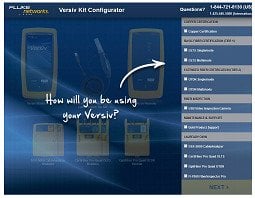Where Will I Testing Cat 8 Cabling Systems with Cable Tester
May 3, 2017 / General, Installation and testing, Upgrading and troubleshooting, Industrial Networks
By now you probably know that Category 8 cabling was approved by the TIA TR-42.7 Copper Cabling Subcommittee, and maybe you've even heard that Fluke Networks introduced the DSX-8000 CableAnalyzer, the first field tester independently verified and endorsed to meet all of the requirements for the Cat 8 field testing standard.
 But do you know where and why Cat 8 cabling systems will need to be tested?
But do you know where and why Cat 8 cabling systems will need to be tested?
While no one knows all of the future applications that might someday call for Cat 8, it is primarily designed to support IEEE 802.3bq 25G/40GBASE-T. Published in September 2016, 802.3bq defines minimum transmission characteristics to support 25 Gbps and 40 Gbps over twisted pair cabling, and we have a good idea of exactly where this application will reside.
At the Edge
While no vendors are currently shipping 25/40GBASE-T equipment and Cat 8 cabling solutions, you can bet that they'll be arriving soon. And when they do, expect them to reside at the edge of the data center to support switch-to-server links over distances up to 30 meters--the same area of the data center where Cat 6A cabling and 10GBASE-T is currently prominent.
Data center upgrades from Cat 6 or Cat 6A to Cat 8 will be straightforward. These structured cabling configurations are typically row based with edge switches and their corresponding patch panels residing in an end-of-row or middle-of-row networking cabinet (or rack) and servers and their corresponding patch panels located in the other cabinets (or racks) within the row. With the 30-meter distance offered by Cat 8 (similar to the 35-meter distance for 10GBASE-T over Cat 6 or over 6A in low-power short-reach mode), networking cabinets may also be in their own distribution area and connected to separate clusters of server cabinets.
So you’ll be doing your Cat 8 permanent link testing for one end at the patch panel in the networking cabinet and for the other at the patch panel in the server cabinet.
Why Cat 8 and 25/40 Gbps?
With backbone data center switch-to-switch fiber links capable of transmitting at 100 Gbps, and IEEE already looking at 200 and 400 Gbps, 10 Gbps will soon no longer offer enough bandwidth for today's virtualized servers in cloud, hyperscale and some advanced enterprise data center environments. And while fiber will support Ethernet rates up to 40 Gbps, copper cabling systems remain less expensive due to lower installation costs, power usage and electronics costs. This makes Cat 8 and 25/40GBASE-T the next logical step.
Some data centers may choose to use direct attach cables (DACs) like SFP28 solutions for higher speed 25 Gbps (25GBASE-CR) direct switch-to-server connections. But unlike the 30-meter distances supported by Cat 8, these solutions are limited to about 5 meters, which can significantly limit flexibility of switch and server placement in the data center. That's why SFP28 cables are typically only deployed in top-of-rack configurations where edge switches reside in the same cabinet and connect directly to servers in that cabinet.
And, unlike 25GBASE-CR, 25GBASE-T/40GBASE-T supports autonegotiation, which provides the ability to support both 25 and 40 Gbps server uplinks to a single switch for efficiency, cost savings and scalability.
What's Next?
With no Category 8 components currently shipping and no 25GBASE-T/40GBASE-T equipment commercially available, it will likely be some time before you actually need to test a Cat 8 cabling system.
But if you're in the market for a new cable tester, the good news is that Fluke Networks' DSX-8000 CableAnalyzer meets all the requirements for testing 25G/40GBASE-T applications over Cat 8 cabling per the ANSI/TIA-1152-A field testing standard that defines the field test methodology and Level 2G accuracy for Cat 8 testers.
You might be asking yourself why you would need this tester now if you're not going to be testing Cat 8 for another year or more. Consider this: Testers are an investment that most contractors expect to last for several years (we have lots of customers still using their thirteen year old DTX’s), and the DSX-8000 can ensure you'll be ready for when your customers do start deploying Cat 8 technology--whether that's in six months or twelve.





